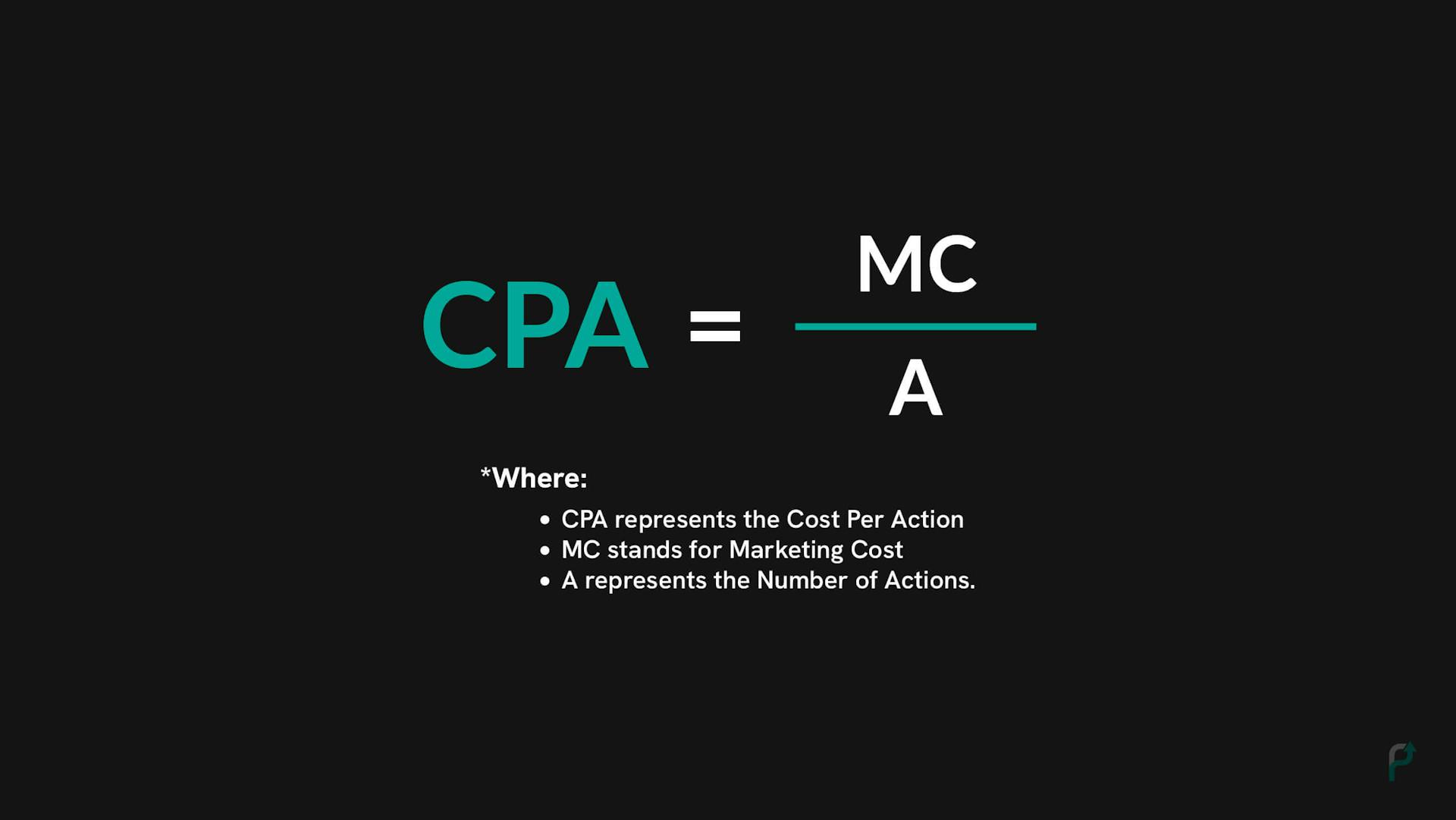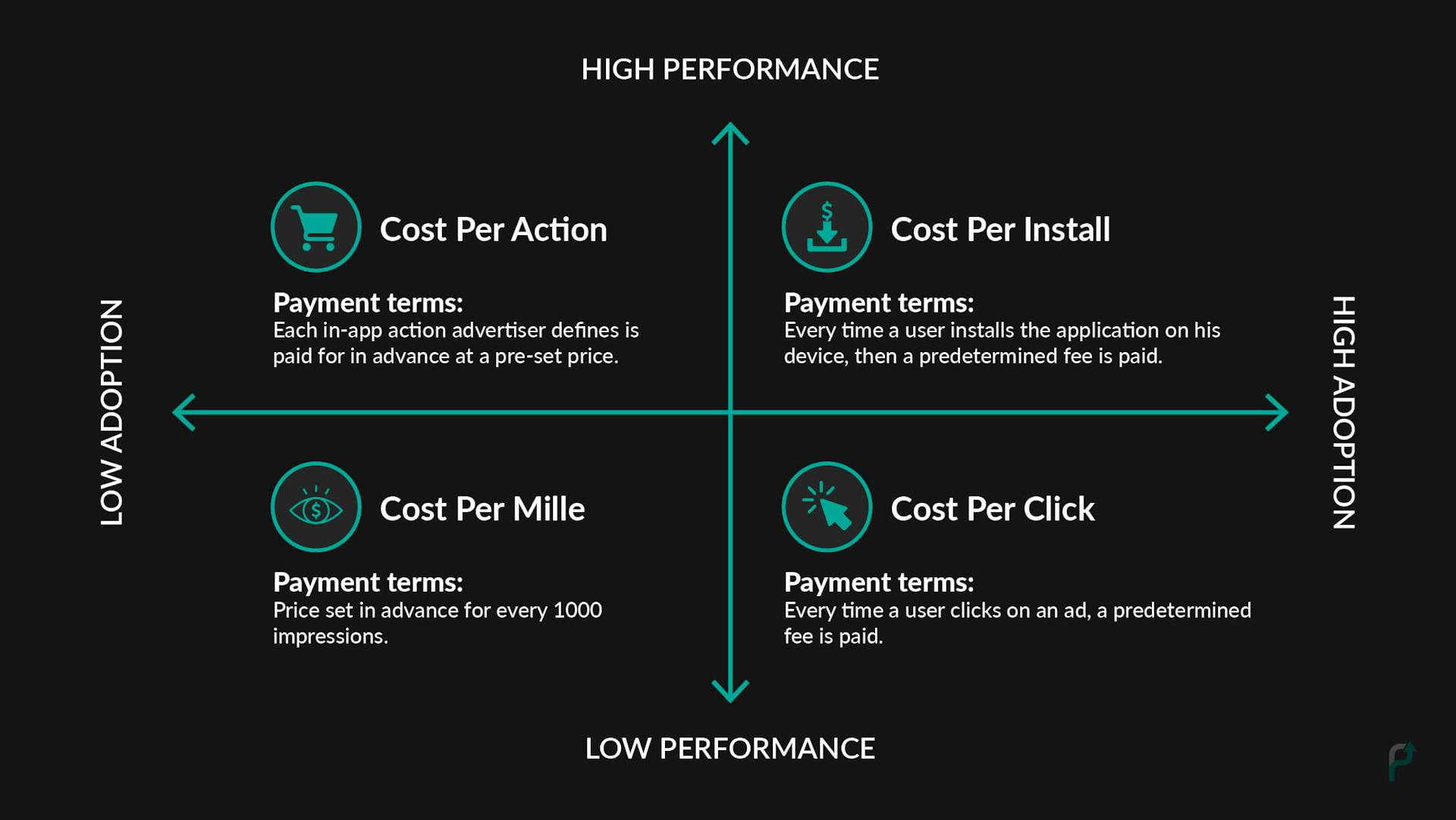- Find out everything there is to know about Cost Per Action (CPA) and CPA marketing, including their definitions, calculations, significance, and how they work.
- Finally, we'll summarize the post by presenting the four best CPA marketing strategies to help you increase your Return On Investment (ROI).
Clicks might seem like the ultimate benefit in paid acquisition. However, if you think about it, clicks merely indicate whether readers are accessing your content or not. Whether they stay there or not is not made clear.
Most acquisition marketers use the cost per action pricing model because it allows them to define an acquisition before initiating advertising and only requires payment when the intended activity occurs.
Here, let's define what Cost Per Action (CPA) means:
What is Cost Per Action (CPA)
The overall cost incurred to get your users to take the necessary actions is known as the Cost Per Action (CPA). Typical examples of this action are sign-up, install, registration, and purchase.
To calculate the Cost Per Action (CPA), use the following formula:
 CPA (Cost Per Action) Formula
CPA (Cost Per Action) FormulaCPA = MC/A
By dividing the total marketing cost by the number of actions taken, we can determine the cost per action.
What is Cost Per Action Marketing
Cost per action marketing is an affiliate technique that involves a collaboration between an advertiser and an affiliate. The affiliate is responsible for providing marketing assistance to the advertiser. When a user responds to the marketing strategy by performing a specific action, the affiliate receives a commission.
CPA marketing comprises advertisers, affiliates, and CPA networks.
Let's understand these terms in this context:
Affiliate or Publisher
An affiliate is an influencer, publisher, or content creator with a built-in following who operates a blog, website, or business is commonly considered an affiliate. Affiliates collaborate with advertisers to promote their products, e-commerce websites, or online stores.
Advertiser or Business
The advertiser or business is a brand that collaborates with an affiliate to market its products to improve the final outcome by attracting high-quality traffic to its brand's website.
CPA Network
An advertiser and publisher communicate through a CPA network, which is often a business whose primary intent is to filter out inexperienced publishers and assist advertisers in discovering beneficial offers from publishers who are most likely to generate leads.
In addition to managing dealings between advertisers and publishers, CPA networks often handle payments.
Types of CPA Marketing
There are various types of CPA (Cost Per Action) marketing strategies that advertisers and publishers employ to drive customer engagement and generate revenue. Let's explore these different approaches:
-
Pay Per Sale
When a customer purchases a product as a result of the affiliate's marketing efforts, the advertiser pays the publisher a percentage of the product's sale price. The publisher is only paid when a sale occurs.
-
Pay Per Action
When a customer completes a specific action, such as visiting the advertiser's website or app, subscribing to a newsletter, making an in-app purchase, or signing up for a trial, the publisher receives a commission.
-
Recurring Payments
In the recurring payments affiliate model, the publisher receives a commission every time the user makes a subsequent purchase. This is different from many affiliate programs that only provide a one-time compensation when a customer completes a transaction.
With cost per action marketing, advertisers select a post-install action to scan mobile user acquisition campaigns and only pay for users who successfully complete that action.
As a result, in order for advertisers to receive payment, users must view, install, and use their in-app advertisements. Advertisers can choose any desired activity for CPA advertising, such as signing up for a free trial, downloading a product, making a purchase, etc.
In this model, advertisers compensate media groups or ad networks for specific conversions (such as a purchase or registration) that takes place within an app as a result of interacting with an advertisement.
For example, a gaming business can utilize cost per action marketing to promote its game downloads. By doing so, businesses can ensure that they only pay for advertising when users actually download their game, rather than simply viewing the ads.
What is the Process of CPA Marketing
 Process of CPA Marketing
Process of CPA MarketingTo understand how CPA marketing works, let’s break down the CPA model below:
Step-1: The affiliate posts an ad for an advertiser on their website or app.
Step-2: The consumer clicks the link or the advertisement.
Step-3: A tracking link directs the consumer to the advertiser's website or app.
Step-4: On the advertiser's website or app, the consumer places an order.
Step-5: The affiliate network keeps track of the dealing's purchasing information.
Step-6: The advertiser approves the transaction as a valid sale.
Step-7: The referring affiliate receives transaction certification.
Step-8: The agreed-upon commission is paid to the affiliate.
What makes Cost Per Action significant?
The four contemporary price models most often used in mobile marketing campaigns are CPA, coupled with:
- CPM (Cost Per Mille)
- CPI (Cost Per Install)
- CPC (Cost Per Click)
The need for a pure performance model has grown as marketers' resources, tools, and techniques have become more sophisticated. This is to ensure that they can make payments as close as possible to the planned output.
The CPA model also makes it easier for media sources to obtain advertising budgets from performance marketers, who may have previously been unwilling to spend money on advertising that is not directly related to the actual value.
This has led to the transition of pricing models from the more vanity-driven cost per mille (a thousand impressions) to cost per click and, finally, cost per install. Although this is a significant step in the funnel, it does not guarantee revenue generation.
CPA is a prominent preference among the pricing models currently available now on the market since it directly reflects campaign profitability and imposes little cost risk on the marketers.
However, networks very seldom provide CPA as a pricing option since they bear the majority of the risk associated with lower conversion, despite its popularity among marketers. This is because the ad networks may purchase ad space before customers convert, and advertisers pay conversion charges.
With Cost Per Action (CPA) advertising, you only pay for outcomes, which is its main advantage. Therefore, you won't be charged for advertising if you don't achieve the intended results. This helps marketers save funds by focusing solely on their goals and picking the most effective advertising channels to reach those objectives.
Furthermore, goal-tracking is simplified through cost per action ads because only specified actions are measured, making it easier to effectively track goals. For example, an advertiser running ads for game downloads can keep track of the number of downloads generated from a specific ad.
Since payment for advertisements relies on successful activities, advertisers have more control over tracking and maximizing return on investment across various marketing channels.
By monitoring CPA, you can make sure that your money is allocated to the most cost-effective app marketing strategies for you while also assessing the performance of each CPA campaign.
 Significance of Cost Per Action
Significance of Cost Per ActionAdvantages of Cost Per Action Marketing
CPA marketing is effective because it provides businesses access to an extensive audience while boosting Return On Advertising Spend (ROAS). Here is a glance at some of the main benefits of cost per action advertising:
-
Integrated Advertising
To reach a larger audience, consider working with publishers to promote your products. Promoting your products on the websites of content creators and influencers can help establish your brand's reputation and reach a bigger market, as these individuals have loyal followings. By doing so, you can consolidate all of your marketing under one roof in a streamlined manner.
-
Lower Risk
With CPA marketing, you only pay when conversion occurs, making it a low-risk affiliate marketing method. This greatly reduces the possibility of affiliates manipulating the system to inflate clicks or website traffic. As a result, the suggestions you receive are more likely to be legitimate and provide value.
-
Higher ROI
CPA marketing is cost-effective because you only pay a commission when there is a successful conversion, leading to a higher Return On Investment(ROI). Commissions can be paid as a flat fee or as a percentage of the sale price.
-
Quick and Simple
To kickstart a CPA marketing campaign, simply choose a CPA network and an offer. There is minimal initial investment required. You can designate an affiliate manager to handle affiliate arrangements on your behalf, and your chosen payment processor can set up an automated commission payment system to manage compensation payments.
CPA marketing requires employing various strategies to establish a mutually beneficial partnership between advertisers and affiliates. Affiliates can improve their earnings by implementing the following cost per action marketing:
The Best CPA Marketing Strategies: 4 Tips
-
Conduct in-depth research to discover good offers
Discover the top CPA marketing opportunity websites through research. These websites function as CPA search engines that present affiliates with numerous offers from reliable CPA networks.
-
Join a user acquisition platform
Joining a user acquisition platform or a CPA network allows you to select a CPA offer and generate referral traffic from affiliate sites, especially if you are a beginner or newcomer to online marketing. Choose a network that provides a robust dashboard for scanning crucial metrics and monetary data. A top-notch CPA network routinely refreshes its offers, ensuring a wide choice of proposals to choose from. Moreover, some CPA networks offer creatives such as landing pages, banners, ad links, and suggested ad content to streamline your CPA marketing campaign.
Also, investigate the network's publisher verification process. Be cautious because if the platform is too lenient, it may admit publishers that don’t meet the required standards.
-
Engage a skilled affiliate manager
Look for an affiliate manager who can help you establish a trusting relationship with your affiliate partners, ensuring their continued promotion of your products.
Affiliates can benefit from the help of a proficient affiliate manager in the following ways:
- They evaluate proposals and suggest partnership strategies.
- They provide suggestions on improving affiliate links or ads for conversion rates.
- They offer creative insights for creating relevant content to promote the advertiser's products.
Concluding Words
In conclusion, strategic planning is essential for expanding the reach of your website, and CPA marketing facilitates rapid growth with no upfront costs. By choosing the most suitable CPA marketing network, you can attain unprecedented levels of revenue.
The only ad platform built for developers by developers.
Contact us now for a product that fits your needs! It’s quick, simple and easy.



